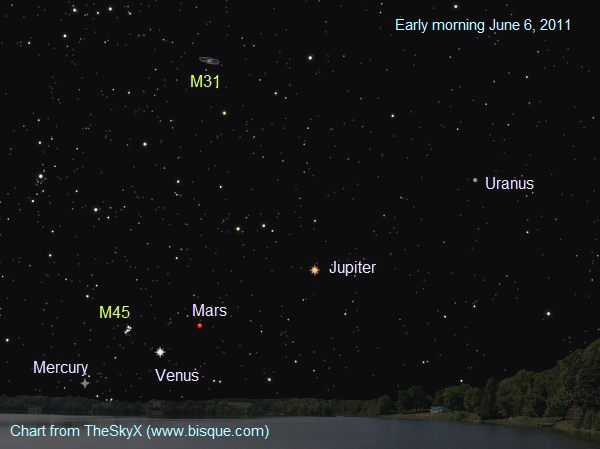Puff The Draco Dragon
The beauty of circumpolar constellations is that they never set below the horizon. From forty-five degrees north latitude, we can enjoy such familiar patterns as Ursae Majoris (Big Dipper), Cassiopeia, Cepheus, Camelopardalis, Draco and of course Ursae Minoris (Little Dipper) which sports the North Star. For the rest of the constellations, that depends on how high or low in declination they reside. This month, we will take a look at the Draco the Dragon.
For countless centuries, the mighty dragon has had a place in mythological stories and folklore. Dragons are usually associated with terror and destruction except with the Chinese culture where the symbol of the fire breathing beast is a positive force. It is said that the creature portrays power and excellence and is believed to bring prosperity and good fortune.
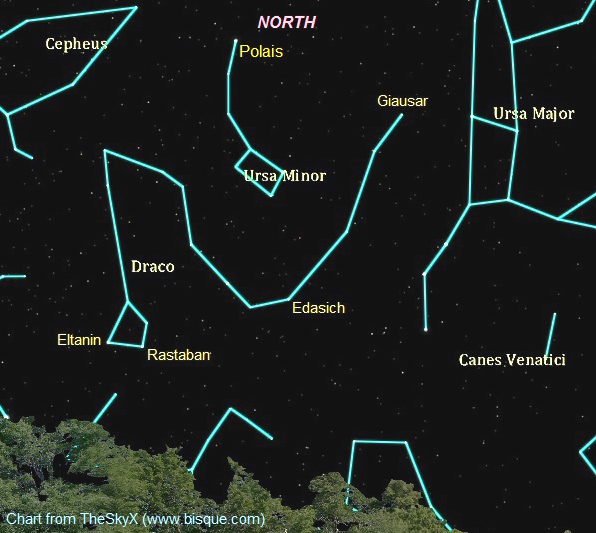
First, locate a crooked rectangle of four stars (Draco’s head) about the same size as the Little Bear’s body. This foursome is plotted north of mighty Hercules, a slayer of dragons. Keep following the slinky trail of stars up to Cepheus and then back down between the constellations of Ursa Major and Minor where is ends. Draco is listed 8th in area with 1,083 spare degrees of territory and has 287 NGC objects within its boundaries. Of the dozen stars that define its shape, the tail star is the most interesting of all.
It is called Giausar and is a very rare red naked-eye star. With a spectral class of M0, it only generates a surface temperature of 3,525 °K compared to the Sun’s G2 class and a 5,800 °K surface temperature. Giausar’s luminosity is calculated to 1,870 times that of the Sun. At a distance of 350 light-years, the star is estimated to be as wide as Mercury’s orbit or 120 million kilometres. By comparison, if the Sun were the size of a ballpoint pen, Giausar would be a golf ball. That is one mammoth star.
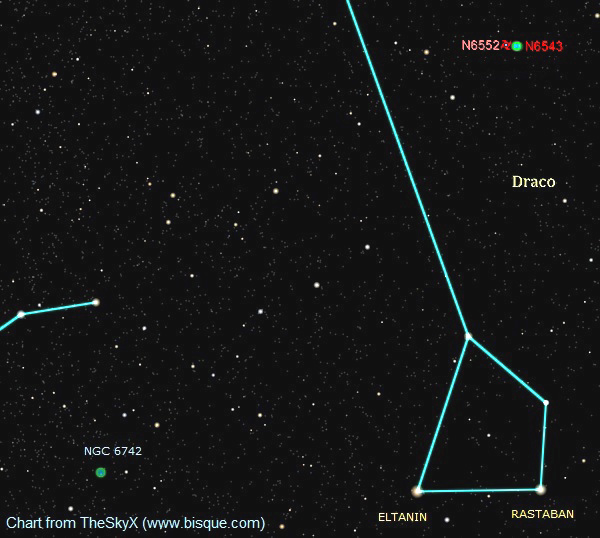
There are only two planetary nebulas with an NGC catalogue number with the rest being galaxies. The first planetary is NGC 6543, dubbed the Cat’s Eye Nebula. At first glance, photos will show it as a complex structure. NGC 6543 is the remains of a star that died about 1,000 years ago. Towards the end of its life, the star was starved for fuel and in the process; it lost its outer shell. But what caused the unique design?
Astronomers believe NGC 6543 could be a double star system, thus causing its spiral appearance. We can thank the Hubble Space Telescope for popularizing this fantastic treasure amongst others. The Cat’s Eye is 3,600 light-years from us, glows at magnitude 8.1 and at a third of an arc minute long, is quite small in size. To the east of the Cat’s Eye is a magnitude 13.8 barred spiral galaxy called NGC 6552. These two objects are separated by 9 arc minutes but the galaxy is 50 million light-years from us.
The second planetary is NGC 6742. A stark contrast to the Cat’s Eye, NGC 6742 is a featureless bluish planetary nebula with its dead star in the centre. However in saying that, NGC 6742 is magnitude 13.6 and quite a challenge to see. This object lies close to the Draco/Lyra border.
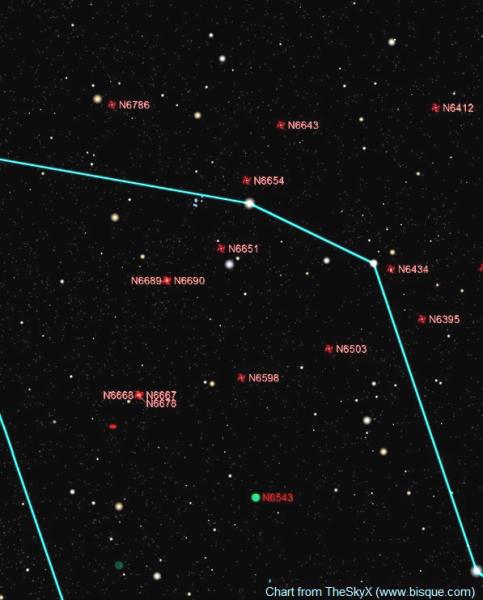
If you are up for a galactic challenge, try spotting NGC 6667. It is a peculiar galaxy some 118 million light-years from us. It has a very low surface brightness of magnitude 15.8 and has no traditional arm structure. If this smudge of ghostly light is too remote for your scope, try NGC 5965. This gorgeous pencil-thin edge-on galaxy measures 5 arc minutes in length but only .8 arc minutes in width. You should also notice NGC 5963, a mere 9 arc minutes west. Both galaxies are in the magnitude 12 range.
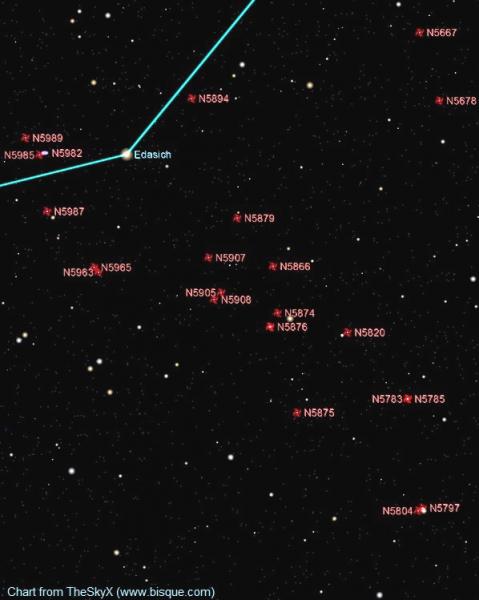
As the month of June opens, look in the east about an hour before sunrise to catch the planets Mercury, Venus, Mars and Jupiter stretching out back into a straight line, with Jupiter leaving the pack. The planet Saturn is now found perched high on the median as the sky darkens. The Lord of the Rings sets around 3:30 a.m. at the beginning of the month.
As for the Moon, it undergoes a new phase on the 1st (lunation 1094). The night of the 9th which is one night past first quarter, look for Rupes Recta otherwise known as the Straight Wall. This will be the best time to observe and image this feature. The Wall is located below Mare Nubium it is an awesome sight in a telescope. The dark shadow during this phase is the result of the Sun’s low angle. The Straight Wall measures 114 km long and football fields in height. The best time is around 10 p.m. EDST for a few hours after.
The full Honey Moon occurs on the 15th with a total lunar eclipse occurring over the Middle East and parts of Europe, Africa and South America. The summer solstice occurs on June 21 at 17:18 universal time and marks for the longest day and shortest night.
And finally, the great summer event of the Royal Astronomical Society of Canada as the Winnipeg Centre plays host to the Annual General Assembly. It runs from July 1 to 3. The GA is a great social event in which fellow society members gather. Numerous paper sessions, local tours and the famous banquet will keep you busy. If you never had the opportunity to attend a GA in the past – you do not know what you are missing.
Until next month, clear skies everyone.
